October 3, 2018

By James Mintert and Michael Langemeier
The Purdue University/CME Group Ag Economy Barometer fell to its lowest reading since October 2016. The reading of 114 in September is 15 points below the August reading of 129.
September marked the second large decline in the barometer this summer, as it also declined in July. The barometer, a sentiment index based upon a nationwide monthly survey of 400 U.S. agricultural producers, has been unusually volatile in recent months. In June, the barometer came in at a reading of 143, but then declined sharply to 117 in July before recovering somewhat in August. This month’s decline was driven by declines in both of the barometer’s two sub-indices, the Index of Future Expectations, which fell 10 points and, especially, the Index of Current Conditions, which fell 25 points, both compared to their respective August readings.
Trade, weather concerns
Concerns about the impact of trade conflicts with major agricultural trading partners, especially China, continue to reverberate throughout the U.S. production agriculture sector. Exacerbating concerns about the impact of China’s tariffs on agricultural products has been unusually favorable weather conditions this summer leading to record yields, and large domestic supplies for corn and soybeans.
Farm financial conditions
Producers indicated that financial conditions on many farms deteriorated significantly as 2018 unfolded and farmers’ expectations for the future weakened as well. On the September survey 54% of respondents said their farms’ financial condition was worse than a year earlier, compared to 47% in August and noticeably worse than the 36% recorded in May and 38% reached in June.
Looking ahead
In September, a third of producers, 33%, said they expect financial conditions on their farm to be worse a year from now, compared to 24% who felt that way in August and just 18% in June.
Concerns extend beyond producers’ own farming operations to the broader agricultural economy. In September, 69% of producers said they expect bad times in the U.S. ag economy in the upcoming 12 months vs. 52% that felt that way in August. As recently as June, less than half (46%) of the respondents expected bad times in the upcoming year. The percentage of producers expecting a protracted downturn also increased on the September survey. This month 41% of producers said they expect widespread bad times in U.S. agriculture over the next five years, up 6 points from August and 10 points compared to the June survey.
Time to make large investments?
The negative perspective on the ag economy was particularly noticeable when producers were asked for their perspective on making large investments in farm machinery and buildings for their farming operation. Just 20% of respondents said now is a good time to make large farm investments and 78% said it was a bad time to make such investments.
Impact of trade conflicts
The impact of trade conflicts on U.S. agriculture and farm incomes continues to be a source of angst among U.S. farmers. For the third month in row, 70% or more of farmers in our survey indicated that trade conflicts are expected to lower their farm’s net income in 2018. In September, 72% of respondents said they expect an income decline of more than 10%, up from 66% that expected an income decline of that magnitude in August and comparable to results from the July survey.
Impact on land
Farmers expect the farm income decline to put downward pressure on farmland cash rental rates and farmland values in the year ahead. Nearly two-thirds of respondents in both August and September said they expect 2019 farmland cash rental rates to decline compared to a year earlier. The percentage of respondents expecting lower farmland values in the year ahead rose to 32% in September, up slightly compared to August and 11 points higher than in May.
The percentage of producers expecting lower farmland values five years from now also rose in September to 19% compared to 14% in August. However, the percentage of producers expecting higher farmland values five years from now rose in September to 46% vs. 42% in August, suggesting the negative outlook for farmland values is focused more on the near term.
Support for relief plan
When asked to what degree does President Trump’s $12 billion relief plan relieve your concerns about the impact of tariffs on your farm’s income the percentage of respondents saying they were somewhat relieved increased slightly to 45% from 43% while 45% of respondents said they were not at all relieved, which was virtually unchanged from August.
Storing more beans
Soybeans are one of the commodities hardest hit by China’s imposition of tariffs on select U.S. agricultural products. We asked soybean growers about their storage plans for the soybean crop being harvested. Nearly one-fifth (18%) of soybean growers plan to store a higher percentage of their production than usual whereas nearly two-thirds (65%) of growers said they planned to store the same percentage of their soybeans as usual. Growers planning to store the same as usual or more than usual this fall were asked if they plan to store most of their soybeans until the trade conflict is settled. Although responses to this question were mixed, it did indicate the trade conflict is skewing some producers’ marketing decisions as 46% said they plan to store their soybeans until the trade conflict is settled. At the same time, 43% of soybean growers in our survey responded no to this question and 11% of growers were uncertain about storing soybeans until the conflict is settled. Finally, among producers storing a higher percentage of their soybean crop than usual (18% of soybean growers in the survey), two-thirds said the trade conflict with China is the primary factor influencing their soybean storage decision.
Source: Purdue/CME Group
You May Also Like




